The 9/11 Memorial Museum: Memorialization or Mind Control?
Part 1 - The Pavilion, the Security Scan, the Tridents, the Descent, Reinforcing the "Collapse" Myth, Artifice
Introduction
On May 29, 2025, I visited the 9/11 Memorial Museum. In part, this was out of grim curiosity regarding how the official “9/11” narrative would be constituted in museum format. But I also wanted to see for myself many of the artefacts I had previously only seen online, and to assess the layout and design of the museum.
As it turned out, I got a lot more than I bargained for. The further I went into the museum, the more evident it became to me that its design, as well as the installations and exhibitions within it, are based on known principles of mind control dating back to the CIA’s MKULTRA program (1953-1963). I describe many of those principles in my book, “Covid-19,” Psychological Operations and the War for Technocracy (2024).
Prima facie, it seems inconceivable that such techniques would be deployed in a museum whose ostensible purpose is to memorialize a national tragedy. Given that multiple architectural and design firms were involved in different elements of the museum, it may also seem unlikely that there would be any overall coordination for nefarious purposes.
Nevertheless, I invite readers to walk with me as I explore the museum, and to make their own minds up. As we will see, the museum is not what it appears to be, and the further one goes, the stranger things become.
The Pavilion
The first thing one sees of the museum is its above-ground pavilion, designed by the Norwegian architectural firm Snøhetta. It was commissioned in 2004, but did not open to the public until May 2014, when the museum was officially dedicated in a ceremony led by President Obama and 9/11 Memorial Chairman Michael Bloomberg.
Perhaps the first thing to note from this angle (I took the photograph) is what a dull and uninteresting building this is — nearly all straight lines and grey, reminiscent of a prison.
Source: steelcell.com
To the extent that “9/11” was used to roll out ever more oppressive measures against Western populations, including the ongoing construction of a digital gulag, the fact that millions of visitors (10 million in the first three years) have paid to go in (with an option for additional donations) and consented to security scans (more on this below) seems perversely fitting.
From the opposite side, as seen from the North Tower memorial pool, a glass facade offers some relief from the otherwise oppressive exterior.
Source: Snøhetta
Here, on the left hand side, the exterior of the building creates an impression of falling or toppling, while its striated facade evokes the Twin Towers. The darker area in the middle is reminiscent of the gash created by whatever hit the towers. The subliminal messaging seems to be that “planes” caused the Twin Towers to “collapse” in a way that is explicable using simple physics. As anyone who has looked into it will know, however, weakened steel and a gravity-driven collapse do not match the observed physics of the Twin Towers’ destruction.
The designer of the “master plan” for the new World Trade Center (WTC) site (which I discuss here), Daniel Libeskind, is perhaps most famous for his Jewish Museum in Berlin:
With “9/11,” we are dealing with another moment of historical rupture and trauma, yet Snøhetta’s pavilion is far cleaner and, in its glass exterior, more glamorous than Libeskind’s design. Compared to the ugly gashes in the Jewish Museum, the exterior of the 9/11 Memorial Museum pavilion barely evokes trauma at all. In fact, with its glass, steel, and innovative use of angles to create surprising effects, it fits in well with the surrounding Manhattan architecture.
Unlike the forbidding outer walls of the Jewish Museum, the 9/11 Museum pavilion actively invites people to come and peer in (and pay money to enter). According to Snøhetta, “Inclined, reflective and transparent surfaces encourage people to walk up close, touch, and gaze into the building.”
Source: snohetta.com
Source: snohetta.com
There is something ethically suspect about this. The 9/11 Memorial Museum remembers a traumatic event whose repercussions have scarred Western society for almost the entire 21st century. Those who visit should make a considered choice to do so, and be prepared for what they are about to encounter. They should not be invited to gaze in, almost voyeuristically, from the outside, and find themselves drawn in as though at a regular tourist attraction.
The 9/11 Museum pavilion occupies a relatively small area above-ground. According to the Guardian in 2014,
Snøhetta’s building has been slashed to a tenth of its planned size, when it was once to hold a museum of human rights and a visual arts centre. It is now essentially a glorified entrance lobby and mechanical service shed for what lies deep below, the memorial museum proper by the businesslike US firm Davis Brody Bond.
The 90% cuts made to Snøhetta’s original design demonstrate the disregard with which human rights are held at the WTC site. I previously noted the lip service paid to inalienable and human rights via the subway propaganda at WTC-Cortlandt. If concern for such rights were primary, they would have been foregrounded immediately upon entrance to the museum in keeping with Snøhetta’s original plans. Instead, they have been relegated below ground and appear almost as an ironic gesture in view of the violations of fundamental rights in the “War on Terror.”
According to one architectural review, the limitations imposed on Snøhetta’s pavilion mean that it was reduced to a “forgettable blandness.” This seems like a fair assessment. Nothing interesting happens there, apart from two trident beams from the Twin Towers greeting visitors as they begin their descent below ground.
Even then, however, the trident beams, which are unmissable through the exterior glass, seem more like a marketing exercise, intended to draw visitors in, than an act of memorialization per se.
The Leidos Security Scanner
Barely had I entered the pavilion than I was struck by the incredible irony of the Leidos security scanner treating all visitors as potential terrorists.
Those familiar with Dr. Judy Wood’s 2007 Qui Tam case — which was brought against Science Applications International Corporation (SAIC) and Advanced Research Associates for their allegedly fraudulent role in advising the National Institute of Standards and Technology on its flawed reports on the destruction of WTC1, WTC2, and WTC7 — will likely know that SAIC changed its name to Leidos in 2013.
According to Kevin Ryan,
With regard to 9/11, SAIC’s impact cannot be overstated as the company:
Created the national databases that tracked and identified terrorists
Supplied U.S. airports with terrorism screening equipment
Predicted and investigated terrorist attacks against U.S. infrastructure including national defense networks and the World Trade Center (WTC)
Helped create the official account for what happened at the WTC both in 1993 and after 9/11
[Supplied the largest contingent of non-governmental investigators to the NIST WTC investigation after 9/11]
Employed the leader of the robotics team that scoured the pile at Ground Zero, using equipment capable of eliminating explosives
Provided the information to capture the alleged mastermind of the attacks, Khalid Sheik Mohammed (KSM)
As noted by Andrew Johnson in Chapter 6 of 9/11: Holding the Truth, SAIC also specialized in psychological operations, and Leidos is a “platinum sponsor” of the Directed Energy Professional Society. Today, Leidos’ subsidiary, Dynetics, provides “directed energy solutions.” In October 2024, it expanded its directed energy business.
Based on the above information, it seems highly likely that SAIC/Leidos, a major government defense contractor, played a key role in the events of “9/11,” with the rollout of a ubiquitous surveillance/security state being a key objective.
Yet, as millions of visitors a year pass through Leidos security as they enter the museum to learn more about the history of “9/11,” how many of them have any conception of the irony, or perhaps deliberate mockery, involved?
The Tridents
Having passed security checks, visitors begin their descent into the museum by passing two giant tridents salvaged from the base of the of the Twin Towers.
Source: archdaily.com
Below are the tridents as they originally stood — during construction, after construction, and from inside the lobby.
Here is what was left of them following the destruction of the Twin Towers:
These remnants were evidently not crushed by a “collapsing” building “pancaking” down upon itself. Indeed, had 110 stories of material really undergone a gravity-driven collapse, with the mass of each successive floor progressively adding to the downwards momentum, ploughing through the path of maximum resistance until most material was “pulverized” at the bottom, there is no chance that the trident beams would have survived.
Such considerations go missing, however, as visitors to the museum descend straight past the tridents without the opportunity for critical reflection.
Source: Archidose
Most visitors will not notice that the trident beams have been moved down, so that their upper horizontal axis is now at ground level, whereas originally it was above.
Source: Los Angeles Times
The whole motion of the architecture is one of descent, even if the viewer’s gaze may initially be directed upwards because of the sheer size of the beams.
Interestingly, the last thing one sees of the above-ground world is One World Trade Center, with the tridents directing attention towards the top of that building. Whether this was deliberate, I cannot say, but it is quite a coincidence if not.
At any rate, the descent below ground begins by looking up at a massive symbol of power, which in turn looks down from a great height. There is something MKULTRA-esque about this power dynamic, whereby the abuser seeks to conjure the illusion of omnipotence while manipulating the unconscious (subterranean) mind through trauma-based means.
The Descent
The idea of descending below ground to gain enlightenment about what happened on September 11, 2001, is enormously problematic. There is a sense of going down into the underworld, or to a dark place where terrible things happened. The low lighting in the museum does not help with that. There is no attempt to illuminate what really took place, just a subterranean journey that risks reactivating unconscious trauma.
According to Snøhetta,
the Pavilion acts as a bridge between two worlds: between the Memorial and the Museum, the above and below ground, the light and dark, between collective and individual experiences.
Or, put differently, the Pavilion acts as a conduit to the underworld, a place of darkness, where the collective unconscious (to borrow Carl Jung’s term) reigns.
There is nothing innocent about this. The literal, physical descent undertaken by visitors to the museum has, as its psychological counterpart, a journey back into the trauma that was unconsciously logged by first exposure to the events of September 11, 2001.
The whole point of trauma-based mind control is that shock and trauma can be used to render the mind susceptible to manipulation and programming. For example, when Osama Bin Laden’s name was mentioned on Fox News just 45 seconds after the second “plane” hit, shocked viewers were primed to accept the “Islamist hijacker” myth.
Similarly, no sooner are visitors to museum below ground, in a strange and unfamiliar place, than they are confronted with the official narrative. The writing is literally on the wall.
The poor quality of this image reflects the low lighting in the museum, which my old digital camera was ill-equipped to cope with.
Visitors then encounter “We Remember,” an installation designed by Local Projects and described as
an audio tapestry from the testimonies of 417 people describing where they were when they heard about the attacks. From the voices of downtown workers to TV news reports and phone calls from around the world, the experience reminds visitors that the shocks of this day reverberated around the world, with an estimated one billion people experiencing the attacks in some way within the first 24 hours.
Source: Local Projects
So, visitors are immediately reminded of the shock that was inflicted, globally, on September 11, 2001. A coherent and familiar reality for everyone, as expressed by the world map, becomes fractured, as happens during a moment of shock. It is replaced by elements of surrealism, as can be seen in the messaging on the left.
The fact that testimonies quickly appear and disappear, both visually and audibly, creates a sense of confusion: it is impossible to take it all in.
The people in the marketing image above are made to seem ghost-like, as though they have died and entered another dimension. There is something of the occult in this.
At any rate, “We Remember” subjects visitors to forms of cognitive disorientation designed to mimic the psychological impact of the day itself. This seems highly questionable from an ethical standpoint, but is consistent with the use of shock for mind control purposes (see Chapter 2 of my book).
9/11 Memorial Museum director Alice Greenwald claims that she wanted to achieve “an emotionally safe encounter with a difficult history,” because
When you are dealing with something traumatic like mass murder and with a subject matter that so many people viewed (an estimated 1/3rd of the world’s population in 2001 watched the events happen on TV), the last thing you want a museum environment to do is traumatize or re-traumatize people or trigger memories that would make them feel uncomfortable.
It seems to me, however, that this is precisely what the museum is intended to do. For example, there is something obviously traumatic about the next exhibit, namely, missing posters projected onto the wall, each one gradually fading in and out, as though to reflect lives being extinguished.
To recap, within minutes of entering the museum, visitors are taken into a strange, underground world where they are exposed to installations which evoke shock and trauma, while being hit with the official narrative.
These techniques derive from MKULTRA and are not consistent with genuine memorialization or the “emotional safety” of visitors.
Reinforcing the “Collapse” Myth
Visitors steadily move down and towards the spaces beneath the memorial pools, where the two permanent exhibitions are contained. They thereby unconsciously mimic the official explanation that the Twin Towers “collapsed.”
Yet, the underground levels beneath the WTC site suffered remarkably little damage, considering that two 110-story skyscrapers weighing an estimated half a million tons each had supposedly just slammed to the ground.
For example, consider the proximity of the PATH (Port Authority Trans-Hudson) train platforms (marked in red below) to the Twin Towers:
Source: Heritage Rail
At the top of the PATH platforms, beneath WTC6, there was no substantial damage to either the platform or the train shown below. Bearing in mind that the PATH platforms were at bedrock level, the Twin Towers supposedly slamming to the ground evidently did not create a powerful blast wind, nor fill the station with massive amounts of debris. The windows of car 745 appeared unbroken.
Source: Heritage Rail
Further down the platform, there was again no significant damage to the exterior of the train or the station, despite a small amount of debris visible four months later.
Source: Heritage Rail
Cars 745 and 143 were retrieved in excellent condition and placed in the Shoreline Trolley Museum in Connecticut.
Source: ctpublic.org
Cars 139 and 612, which were furthest down the platform, were, according to Heritage Rail, “destroyed under the rubble,” although no images are provided. Peter Rinaldi, retired Senior Engineer for the Port Authority, claimed that no one on board the train perished, which suggests that passengers were evacuated before that damage occurred.
Yet, if half a million tons of material from WTC1 had hit the ground right next to the train (whose approximate location I have shaded below), there is no way that car 160 (shown above), located towards the center of the train and only a platform width away from the northeast corner of WTC1, would have survived without any serious damage to its exterior. Nor would the roof of the station above car 160 and the columns supporting it have survived intact. Rather, everything in sight would have been obliterated.
The condition of the PATH train and station is just one piece of evidence among many that the Twin Towers did not “collapse.” To the extent that the 9/11 Memorial Museum was designed to convey a sense of collapse, with visitors moving downwards towards the bottom of each footprint, it is based on a Big Lie.
Artifice
Once underground, visitors continue their descent to the main exhibition area of the museum via a ramp that officially “evokes a history of construction ramps at the World Trade Center site: one to build the original complex in the 1960s and another installed during the post-9/11 recovery period.”
The ramp at Ground Zero. Source: wirednewyork.com
However, the ramp in the museum is nothing like the Ground Zero ramp. It is in a different location, points in a different direction, is much smaller, only descends a couple of levels, and is made of Brazilian timber.
It leads visitors to a viewing platform over the Foundation Hall.
The viewing platform over the Foundation Hall. Source: fmsp.com
It then doubles back on itself and heads round the south side of the North Tower memorial pool.
The ramp doubles back on itself. Source: Archidose
The ramp brings us to the problem identified by Robert Bevan in 2014:
[T]he project starts to become particularly troubling: it feels real but it isn’t. The ramp is an artifice, as are the aluminium-clad tower volumes, as are the arbitrary dimensions of the whole [the physical boundaries of the underground museum having been determined by commercial, rather than aesthetic factors]. The project evokes emotion skilfully but synthetically. Perhaps memorial architecture is supposed to manipulate but this teeters on the edge of falsity. It feels like a gargantuan found object, except it is not authentic fabric apart from the giant artefacts incorporated into it.
Indeed, there is an air of falsity and inauthenticity about the museum that becomes ever more obvious as visitors enter the main underground space designed by US architectural firm Davis Brody Bond. The self-styled “owner representation firm,” Zubatkin, helped with exhibit development and installation.
Quite apart from the fact that the museum serves a predictable propaganda function intended to promote the official “9/11” narrative, it is a highly artificial space. Almost none of what was originally below ground (car parking, air conditioning units, tenant storage, etc.) remains. Virtually everything that is there now was not there before.
The dramatic counter-example is a section of the slurry wall (the concrete retaining wall built to hold back the Hudson River when the WTC site was first excavated in the 1960s) that has been left exposed to the west of the North Tower memorial pool.
The slurry wall on the left, the footprint of the North Tower on the right. Source: Wendy Perrin
The beam in the center of the picture is the “Last Column” which, as its name suggests, was the final piece of steel to be removed from “Ground Zero.”
However, the Last Column was not located west of the North Tower, as per its position within the museum. Rather, it formed part of the South Tower.
Source: 911memorial.org
Historical reality has, thus, been altered, not preserved.
No explanation is given as to why the slurry wall is cut off by a diagonal wall that has been artificially inserted. An architectural schematic does not reveal any obvious purpose to the space behind the wall:
Source: archdaily.com
What is the space behind the wall for? Do the stairs in it bear any relation to the publicly inaccessible underground entrance noted in my previous article?
Although the slurry wall goes down to the bedrock, the floor of the museum is not the bedrock itself. In Bevan’s words, we are looking at “what has been called the bedrock but isn’t quite.”
Even in parts of the floor that have been deliberately exposed, where the bottoms of the outer box columns of the Twin Towers remain visible, we are looking at concrete, rather than bedrock.
Conclusion
In sum, virtually nothing in the artificial space of the museum is quite as it seems. There is remarkably little historical authenticity.
Having been lured in from outside, visitors descend into a chthonic realm of the unconscious and unwittingly find themselves in an uncanny, fake environment in which their perception of reality is distorted. This is hardly conducive to memorialization purposes.
Again, however, it is consistent with MKULTRA and the tactic of placing prisoners in a strange and unfamiliar environment so as to render them psychologically vulnerable and susceptible to programming.
In Part 2, we will continue our journey along the ramp and descend to the very bottom of the museum, where the two main exhibitions are housed.

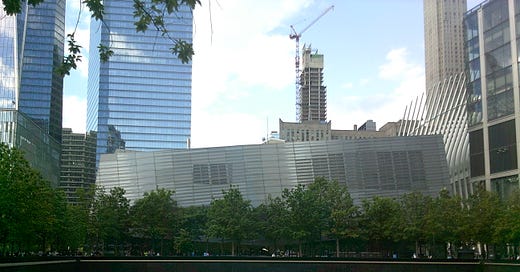


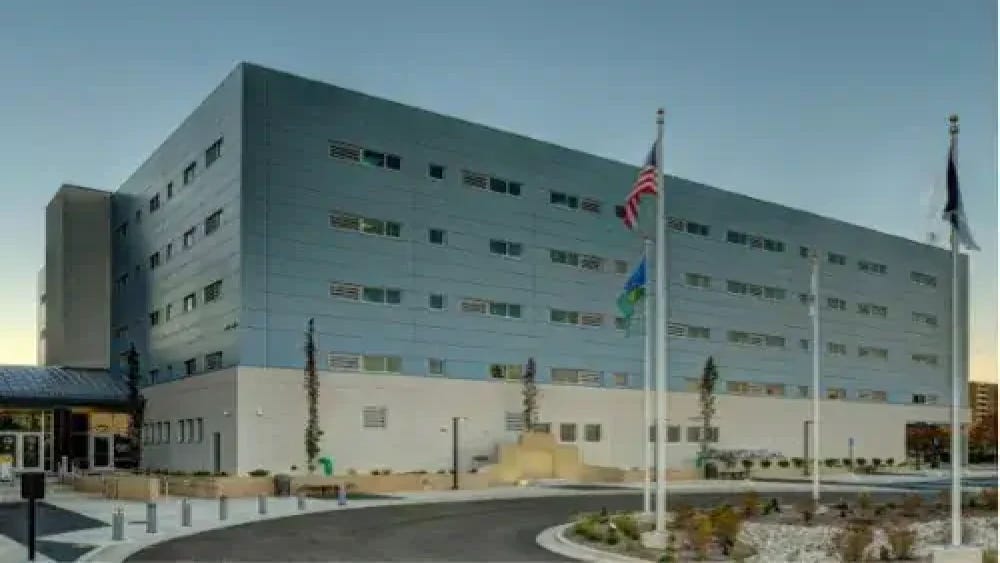

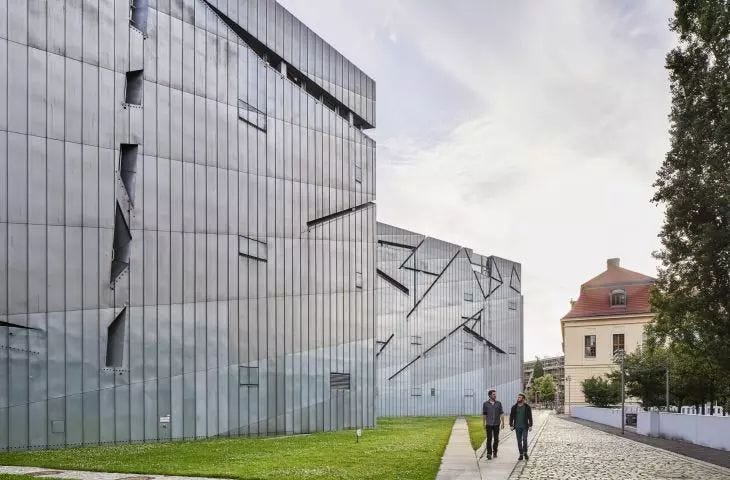
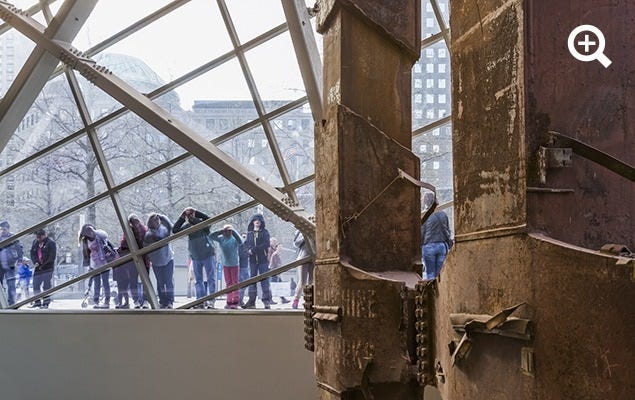

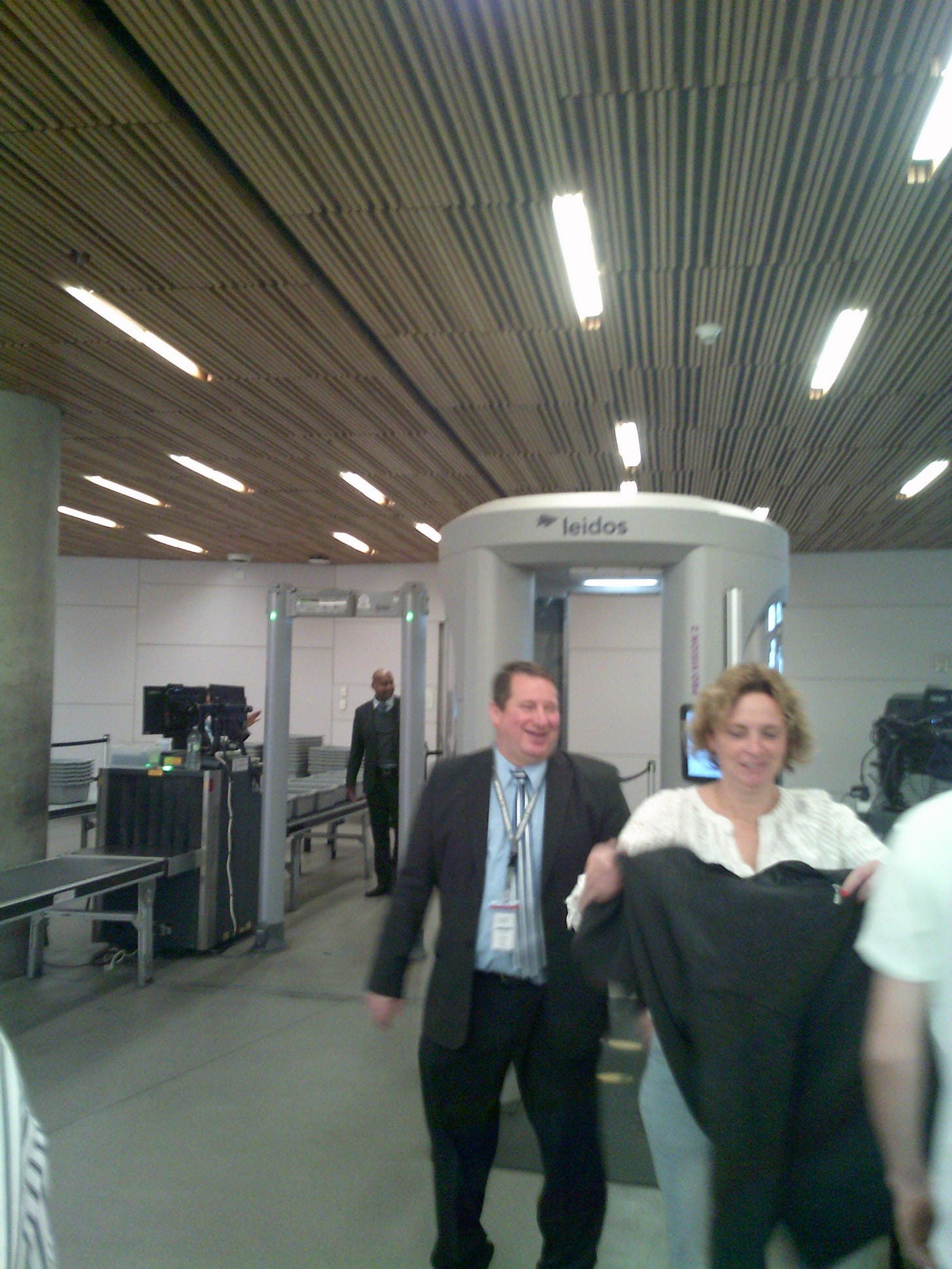


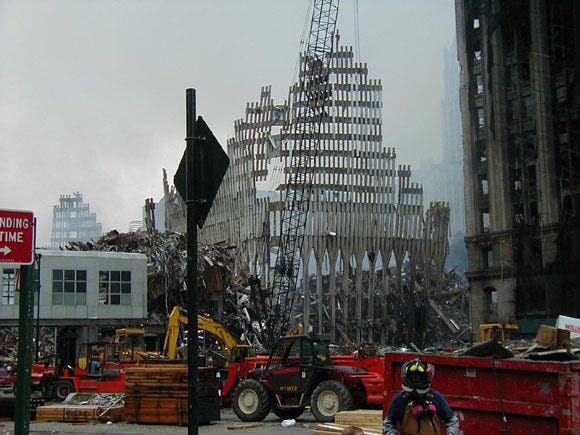
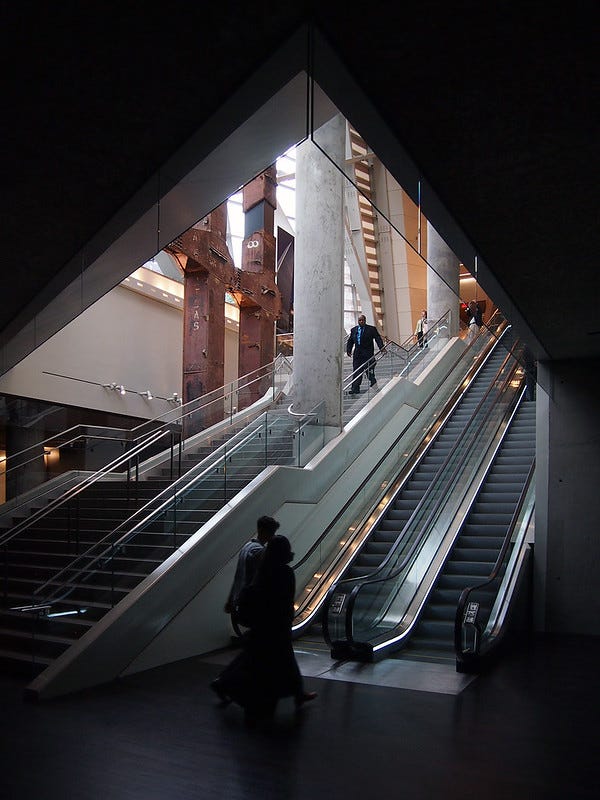
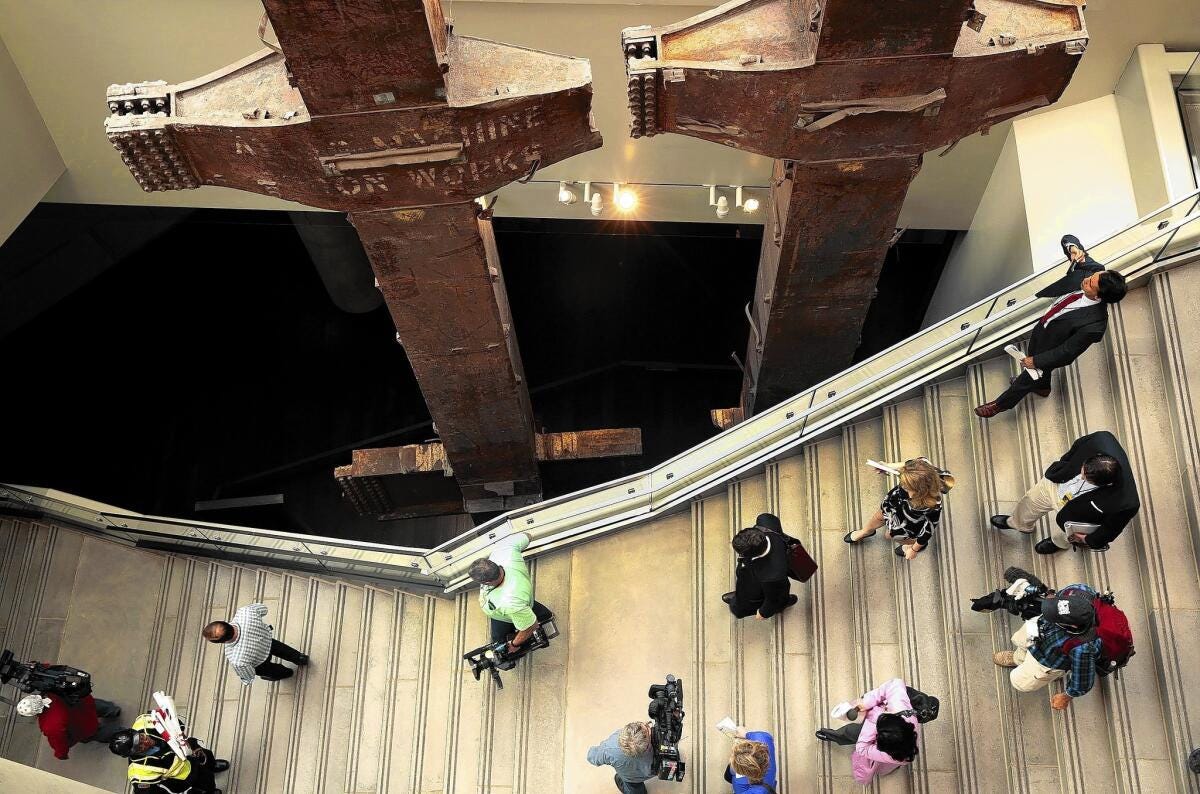



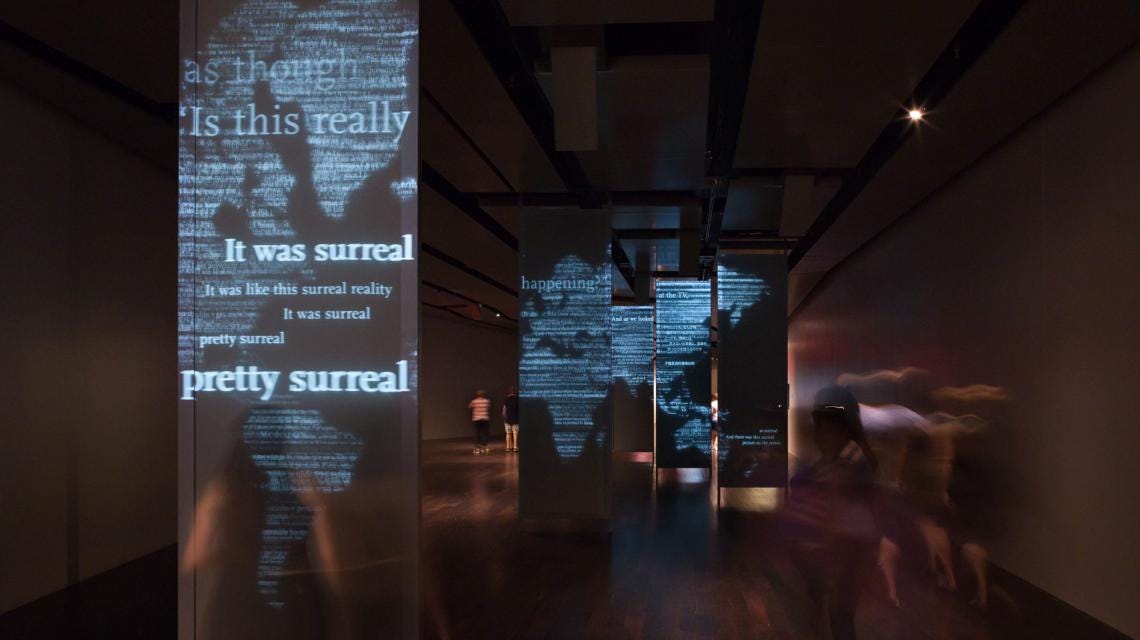
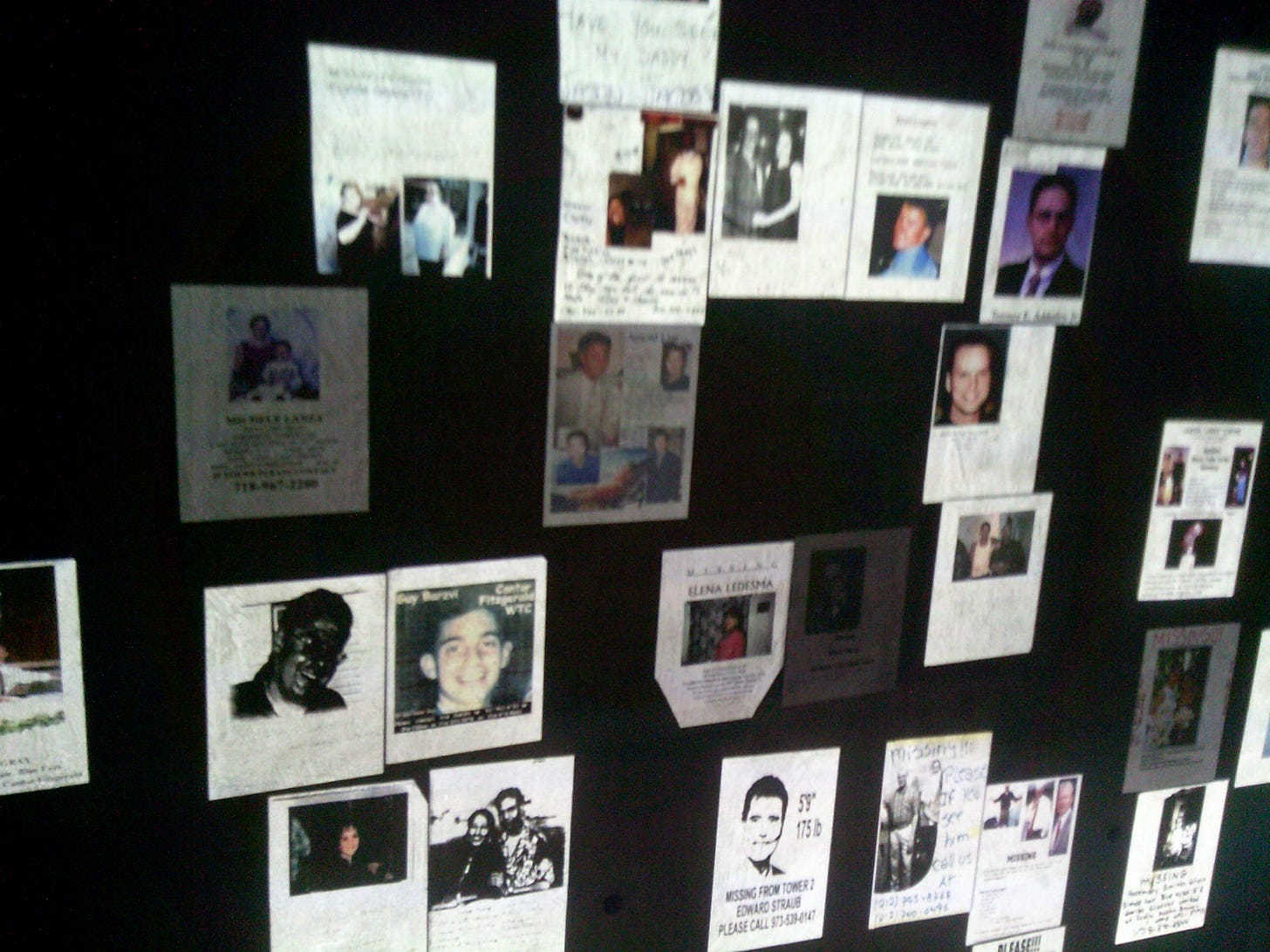
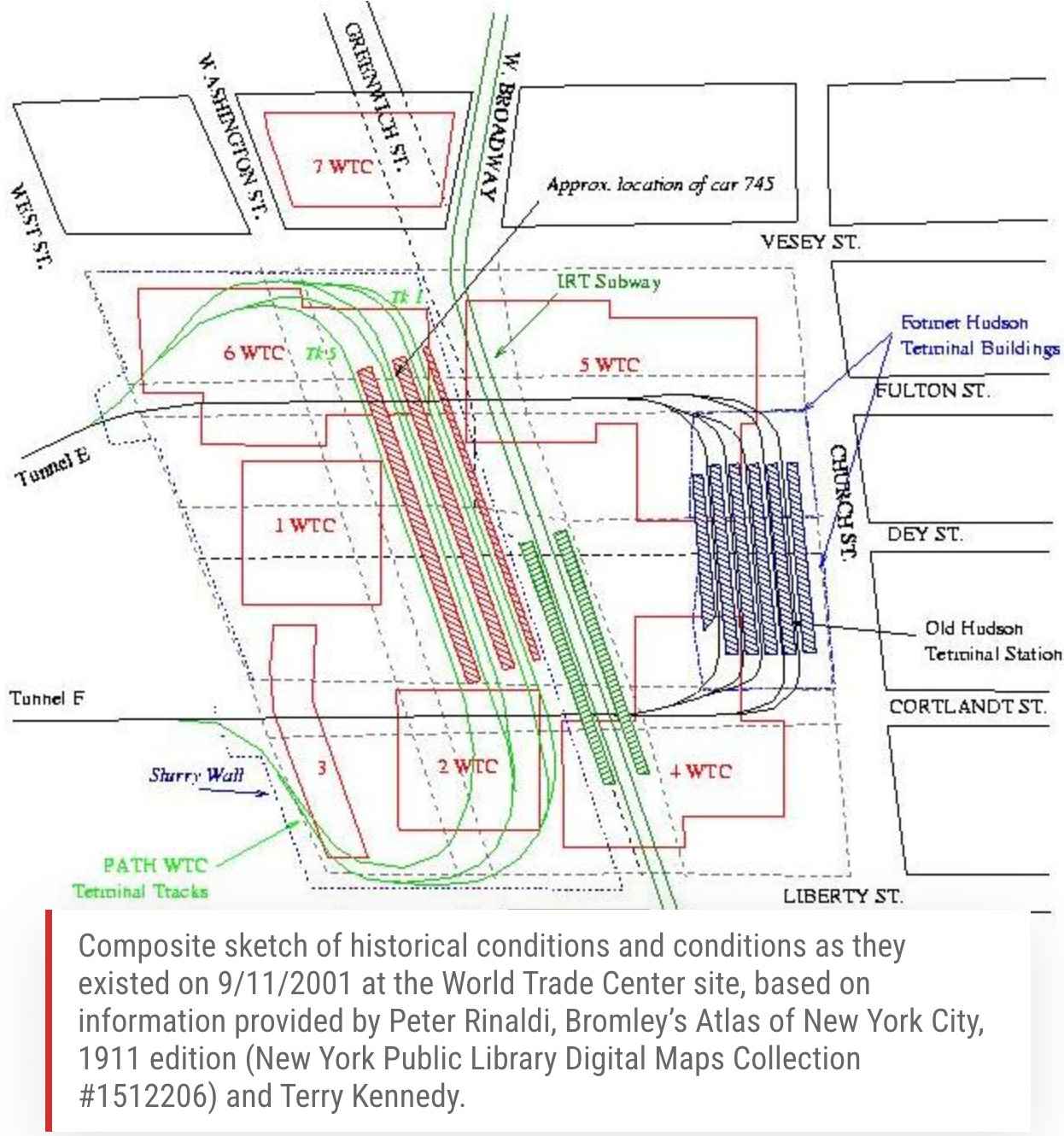
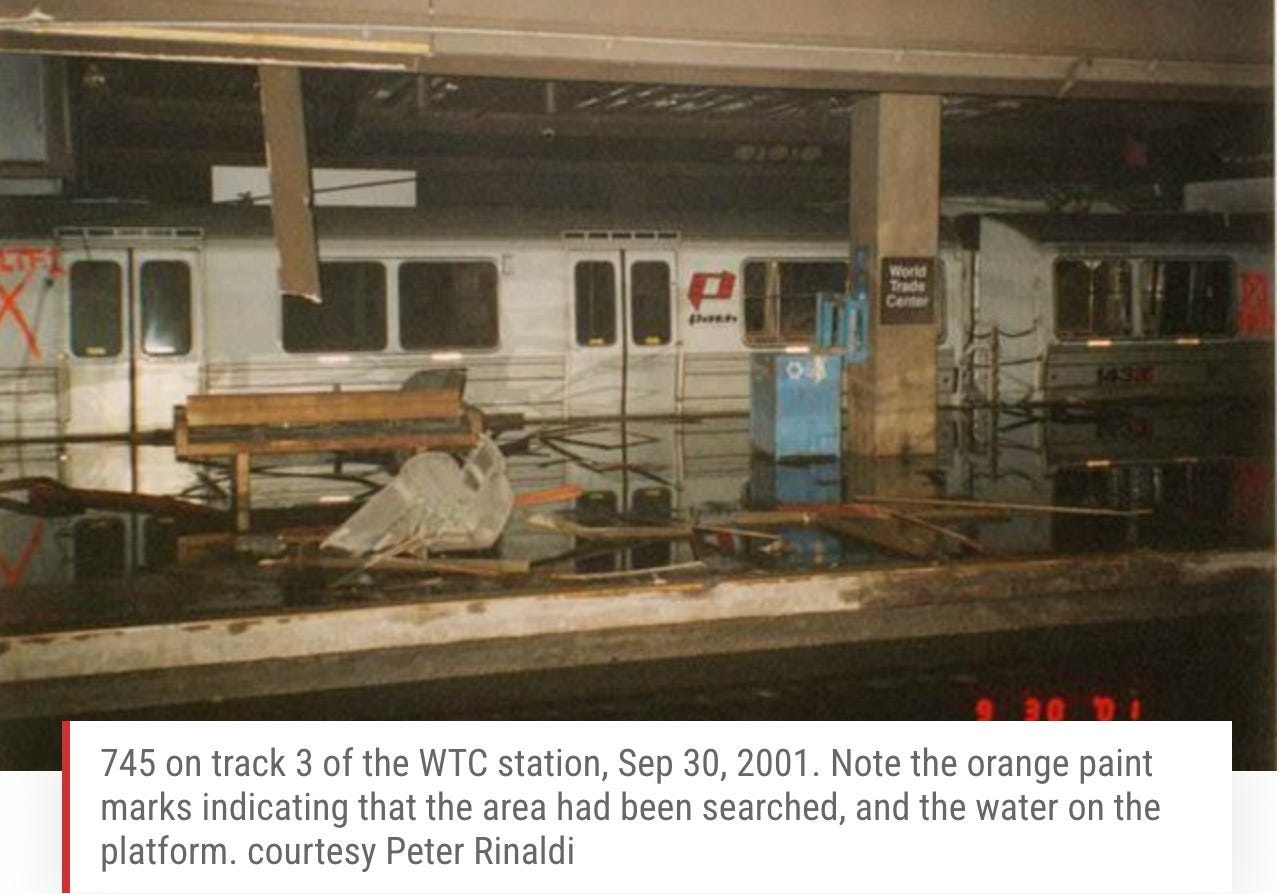
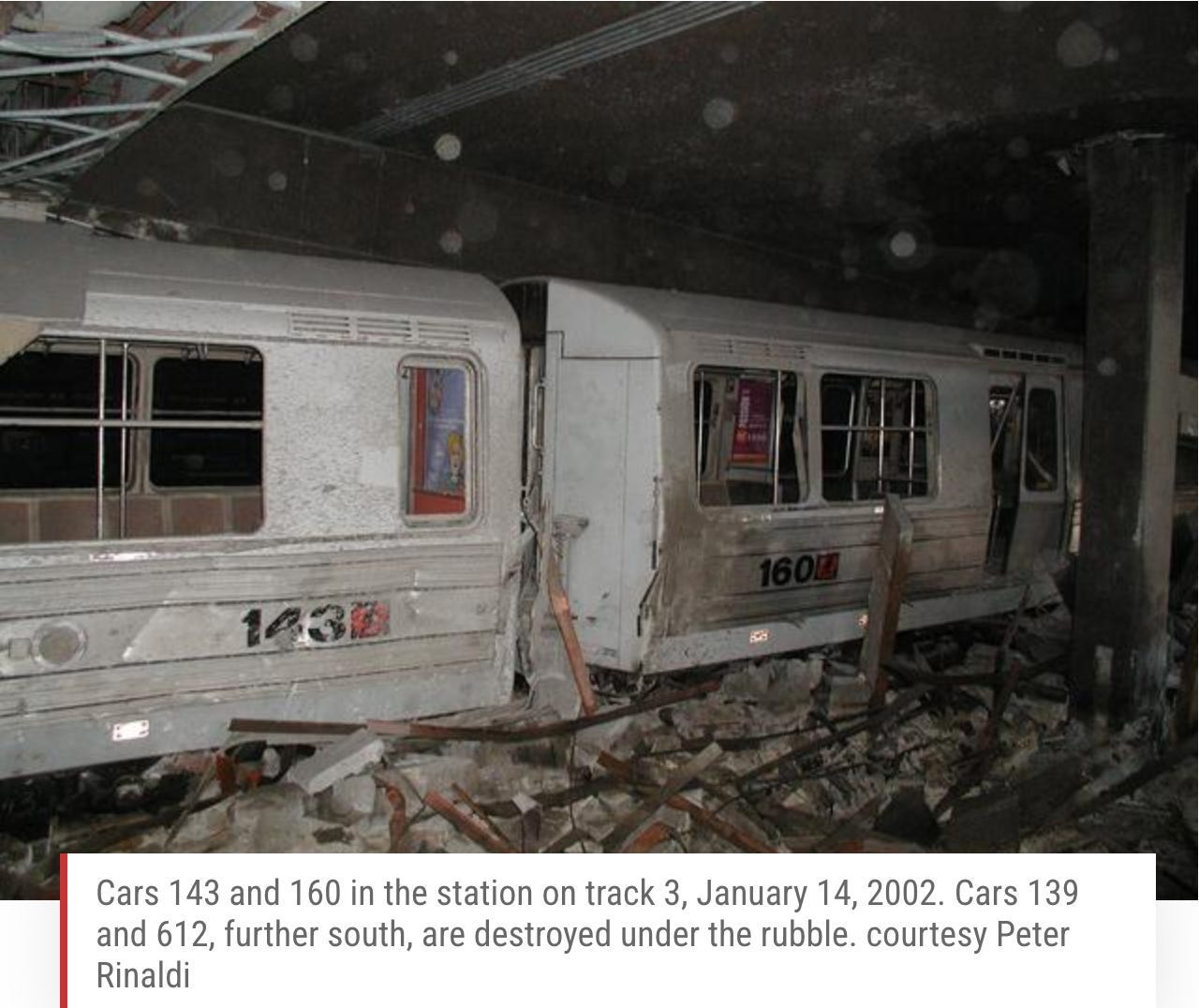
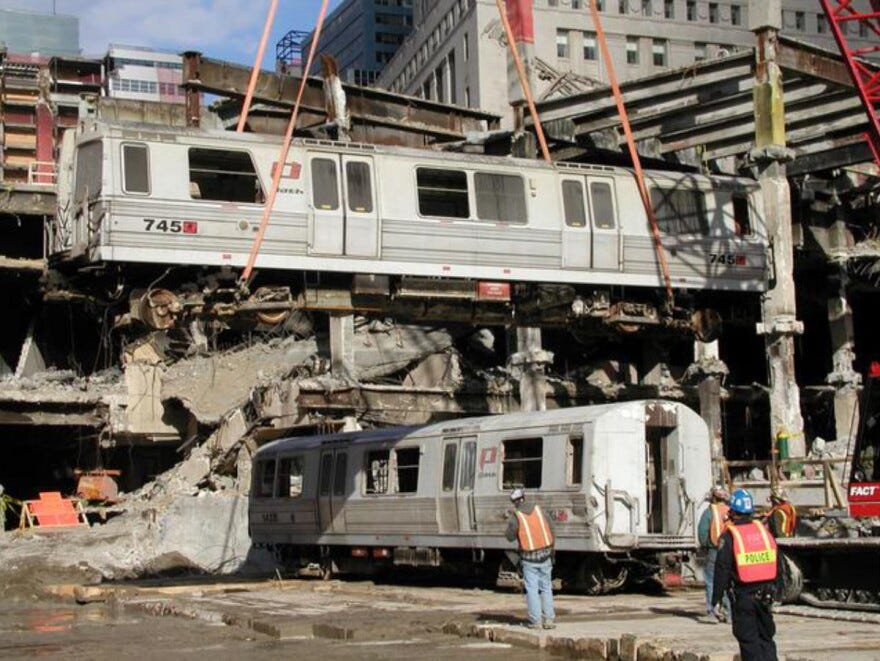

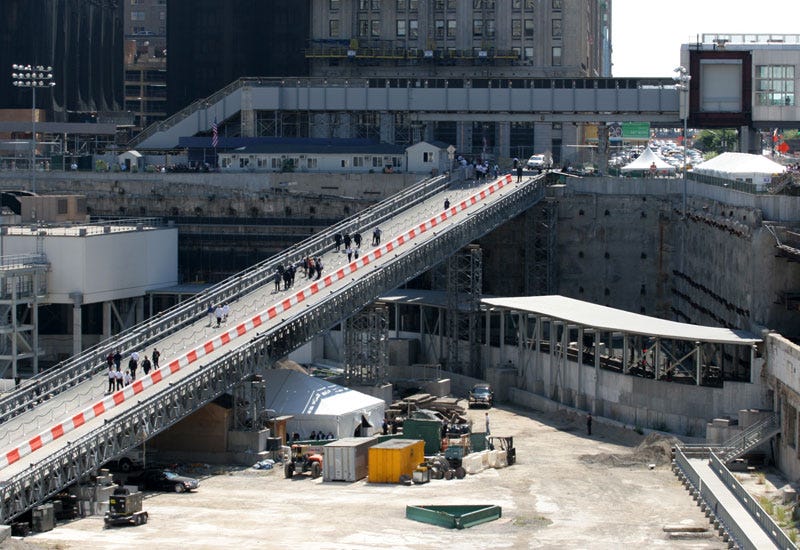
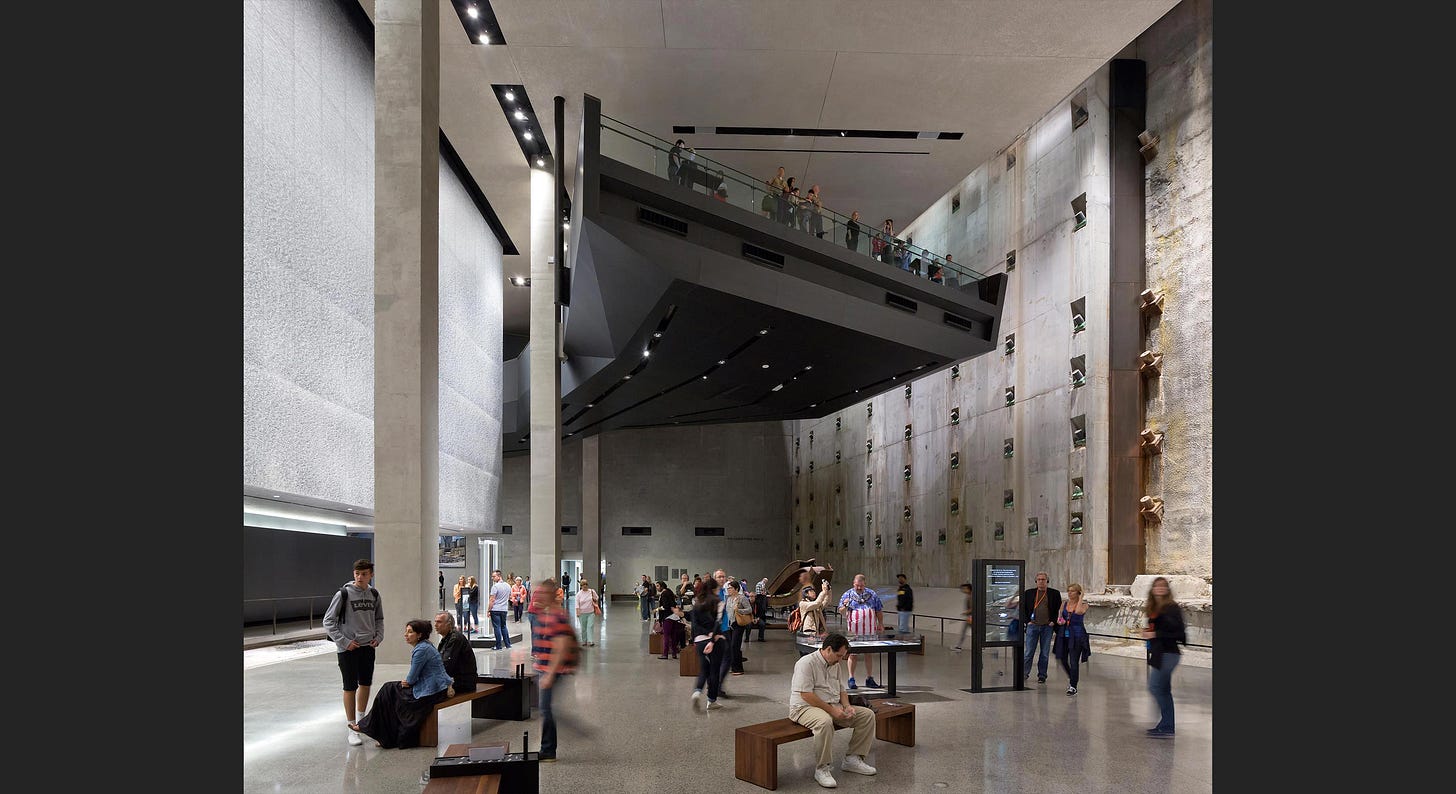
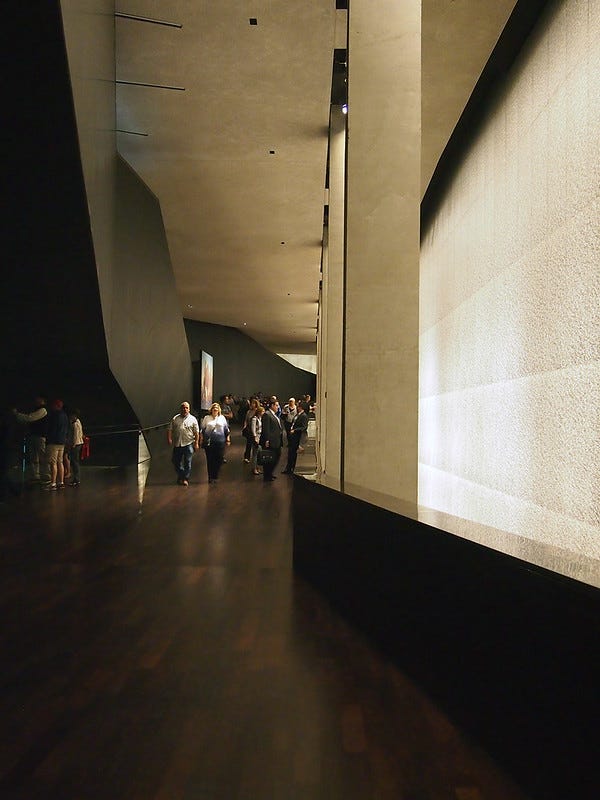

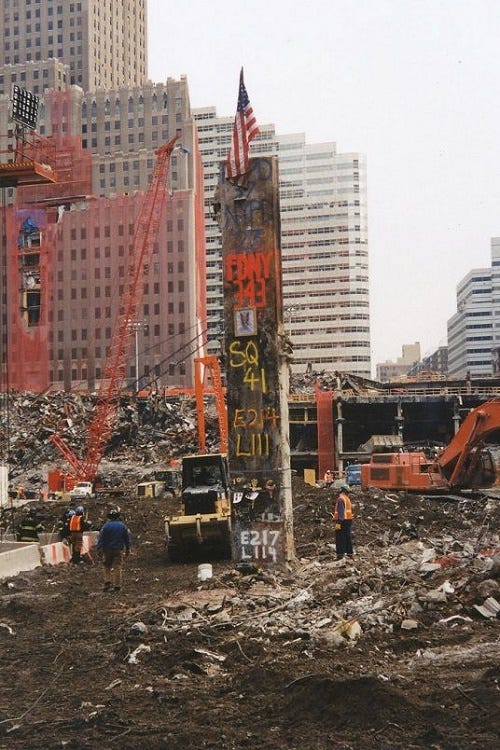

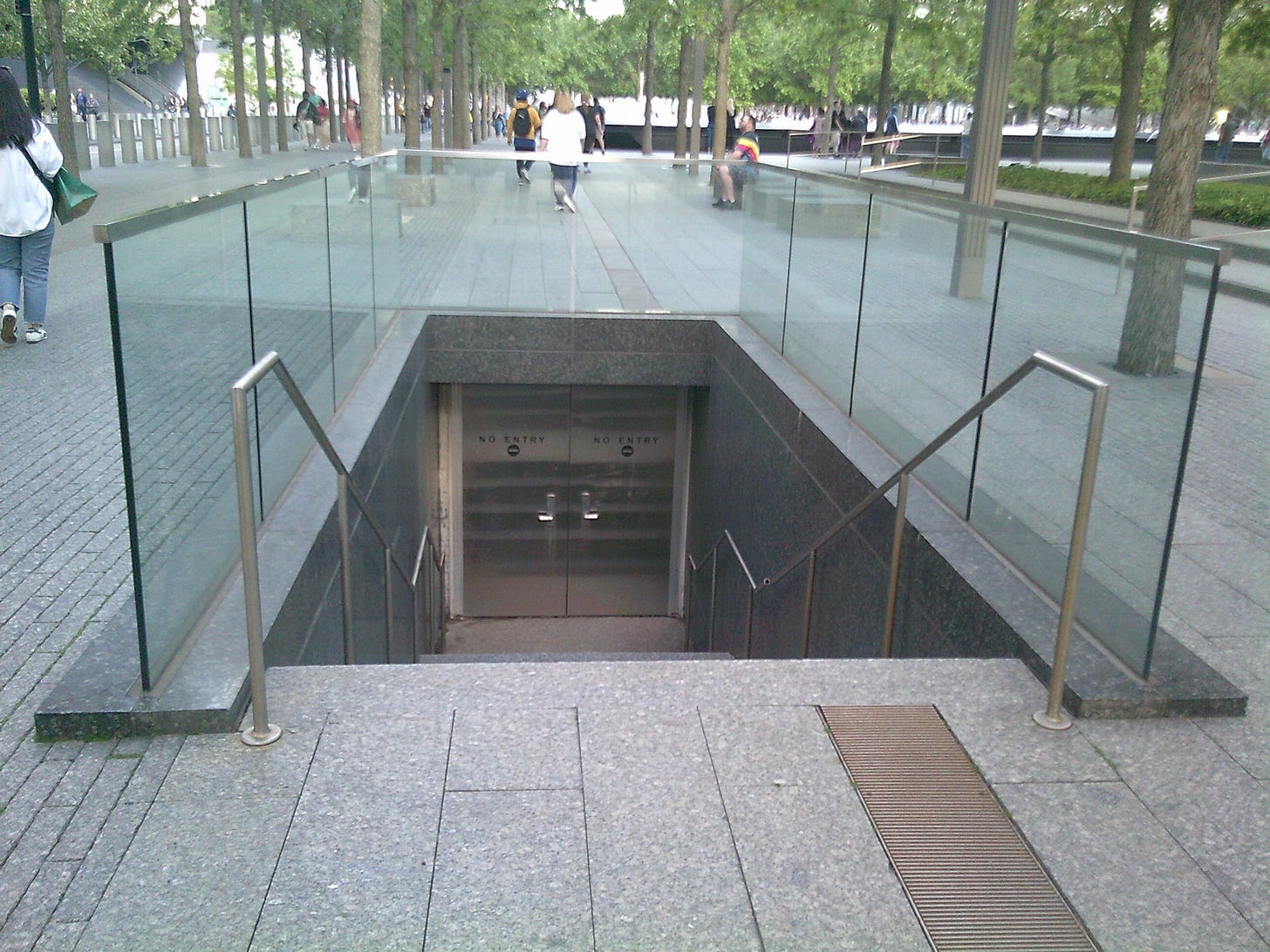
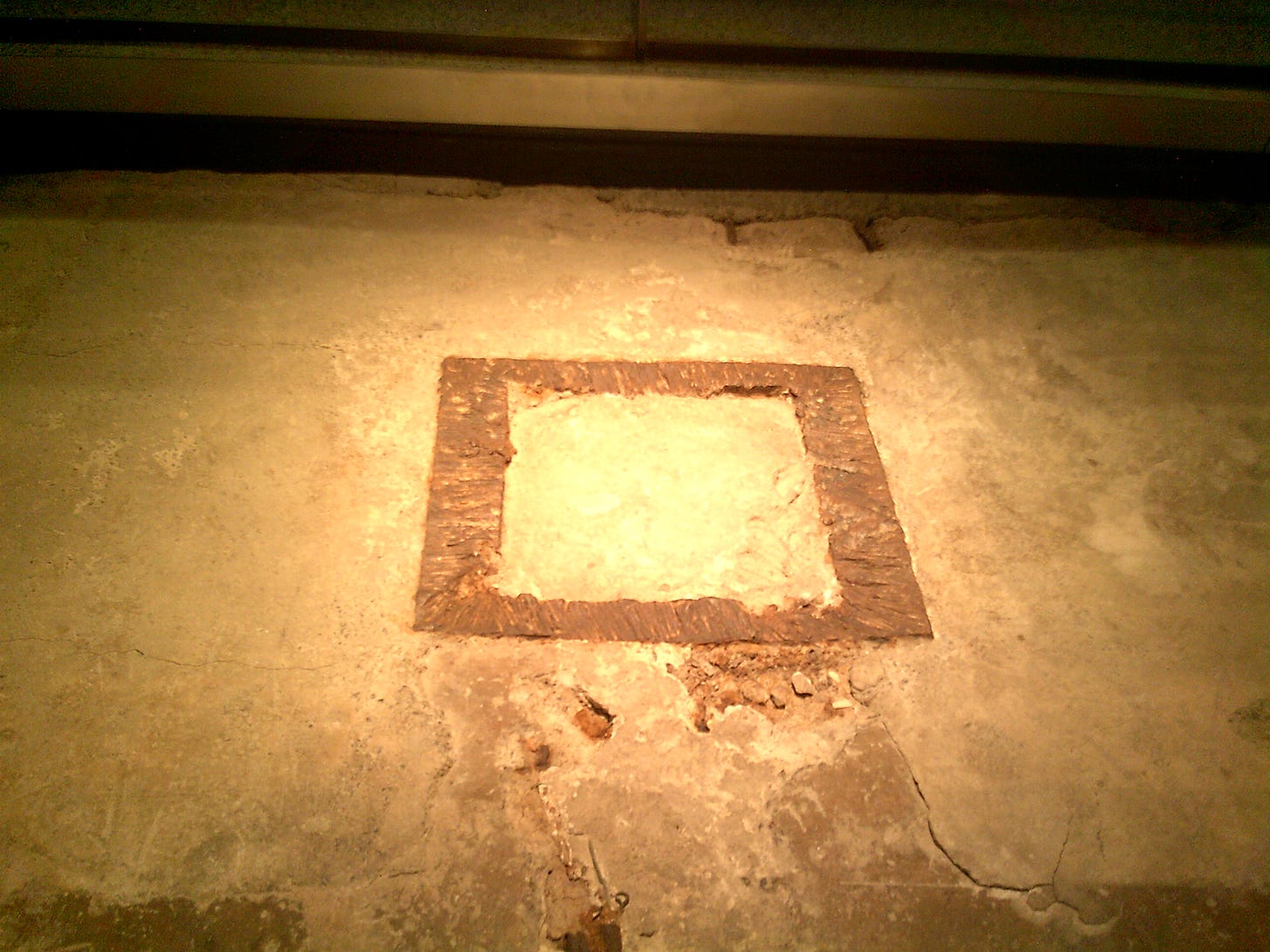
You have made some very important connections here in the symbolism. I have only been to a few national memorials and read about a few others, but the message seems consistent. At the end of it all, it is a spiritual war. To know the abyss is there does not mean we have to stare into it. In fact, we mustn’t.
I am a Native New Yorker who lived through that 9/11 day and as it was happening, knew it was a false flag psy-ops because the air force never scrambled and of course for a lot of other reasons but that was the first thing I thought of.
I am glad you are writing a detailed report about this so-called 'Memorial' travesty, so I don't have to go there and be subjected to it!